Probe Microscopic Studies of DNA Molecules on Carbon Nanotubes
Abstract
:1. Introduction
2. Atomic Force Microscopic Observation of DNA-Carbon Nanotube (CNT) Hybrids
3. Scanning Tunneling Microscopy Studies on DNA-CNT Hybrids
4. Electrical Properties of DNA-CNT Hybrids Studied by Atomic Force Microscopy
5. Mechanics of DNA on Carbon Nanotubes
6. Optical Properties of DNA-CNT Hybrids by Near-Field Scanning Optical Microscopy
7. Fabrication of DNA-CNT Films Using an Atomic Force Microscopy Cantilever
8. Summary
Acknowledgments
Author Contributions
Conflicts of Interest
References
- Dai, H.J.; Hafner, J.H.; Rinzler, A.G.; Colbert, D.T.; Smalley, R.E. Nanotubes as nanoprobes in scanning probe microscopy. Nature 1996, 384, 147–150. [Google Scholar] [CrossRef]
- Engel, A. Biological applications of scanning probe microscopes. Annu. Rev. Biophys. Biophys. Chem. 1991, 20, 79–108. [Google Scholar] [CrossRef] [PubMed]
- Frank, S.; Poncharal, P.; Wang, Z.L.; de Heer, W.A. Carbon nanotube quantum resistors. Science 1998, 280, 1744–1746. [Google Scholar] [CrossRef] [PubMed]
- Gewirth, A.A.; Niece, B.K. Electrochemical applications of in situ scanning probe microscopy. Chem. Rev. 1997, 97, 1129–1162. [Google Scholar] [CrossRef] [PubMed]
- Hofer, W.A.; Foster, A.S.; Shluger, A.L. Theories of scanning probe microscopes at the atomic scale. Rev. Mod. Phys. 2003, 75, 1287–1331. [Google Scholar] [CrossRef]
- Horcas, I.; Fernandez, R.; Gomez-Rodriguez, J.M.; Colchero, J.; Gomez-Herrero, J.; Baro, A.M. WSXM: A software for scanning probe microscopy and a tool for nanotechnology. Rev. Sci. Instrum. 2007, 78, 013705. [Google Scholar] [CrossRef] [PubMed]
- Tseng, A.A.; Notargiacomo, A.; Chen, T.P. Nanofabrication by scanning probe microscope lithography: A review. J. Vac. Sci. Technol. B 2005, 23, 877–894. [Google Scholar] [CrossRef]
- Binning, G.; Rohrer, H.; Gerber, C.; Weibel, E. Surface studies by scanning tunneling microscopys. Phys. Rev. Lett. 1982, 49, 57–61. [Google Scholar] [CrossRef]
- Binnig, G.; Quate, C.F.; Gerber, C. Atomic force microscope. Phys. Rev. Lett. 1986, 56, 930–933. [Google Scholar] [CrossRef] [PubMed]
- Lamprecht, C.; Liashkovich, I.; Neves, V.; Danzberger, J.; Heister, E.; Rangl, M.; Coley, H.M.; McFadden, J.; Flahaut, E.; Gruber, H.J.; et al. AFM imaging of functionalized carbon nanotubes on biological membranes. Nanotechnology 2009, 20. [Google Scholar] [CrossRef] [PubMed]
- Binnig, G. Atomic Force Microscope and Method for Imaging Surfaces with Atomic Resolution. U.S. Patent RE33387 E, 26 November 1985. [Google Scholar]
- Binnig, G.; Rohrer, H. Scanning tunneling microscopy. Helv. Phys. Acta 1982, 55, 726–735. [Google Scholar]
- Binnig, G.; Rohrer, H. Scanning tunneling microscopy. Surf. Sci. 1983, 126, 236–244. [Google Scholar] [CrossRef]
- Giocondi, J.; Rohrer, G.S.; Skowronski, M.; Balakrishna, V.; Augustine, G.; Hobgood, H.M.; Hopkins, R.H. An atomic force microscopy study of super-dislocation/micropipe complexes on the 6H-SiC(0001) growth surface. J. Cryst. Growth 1997, 181, 351–362. [Google Scholar] [CrossRef]
- Smith, R.L.; Rohrer, G.S. An atomic force microscopy study of the morphological evolution of the MoO3 (010) surface during reduction reactions. J. Catal. 1996, 163, 12–17. [Google Scholar] [CrossRef]
- Nakashima, N.; Okuzono, S.; Murakami, H.; Nakai, T.; Yoshikawa, K. DNA dissolves single-walled carbon nanotubes in water. Chem. Lett. 2003, 32, 456–457. [Google Scholar] [CrossRef]
- Zheng, M.; Jagota, A.; Semke, E.D.; Diner, B.A.; McLean, R.S.; Lustig, S.R.; Richardson, R.E.; Tassi, N.G. DNA-assisted dispersion and separation of carbon nanotubes. Nat. Mater. 2003, 2, 338–342. [Google Scholar] [CrossRef] [PubMed]
- Tu, X.; Manohar, S.; Jagota, A.; Zheng, M. DNA sequence motifs for structure-specific recognition and separation of carbon nanotubes. Nature 2009, 460, 250–253. [Google Scholar] [CrossRef] [PubMed]
- Williams, K.A.; Veenhuizen, P.T.M.; de la Torre, B.G.; Eritja, R.; Dekker, C. Nanotechnology—Carbon nanotubes with DNA recognition. Nature 2002, 420, 761. [Google Scholar] [CrossRef] [PubMed]
- Zheng, M.; Jagota, A.; Strano, M.S.; Santos, A.P.; Barone, P.; Chou, S.G.; Diner, B.A.; Dresselhaus, M.S.; McLean, R.S.; Onoa, G.B.; et al. Structure-based carbon nanotube sorting by sequence-dependent DNA assembly. Science 2003, 302, 1545–1548. [Google Scholar] [CrossRef] [PubMed]
- Umemura, K. Hybrids of Nucleic Acids and Carbon Nanotubes for Nanobiotechnology. Nanomaterials 2015, 5, 321–350. [Google Scholar] [CrossRef]
- Cha, T.-G.; Pan, J.; Chen, H.; Salgado, J.; Li, X.; Mao, C.; Choi, J.H. A synthetic DNA motor that transports nanoparticles along carbon nanotubes. Nat. Nanotechnol. 2014, 9, 39–43. [Google Scholar] [CrossRef] [PubMed]
- Jagota, A. On track with nanotubes. Nat. Nanotechnol. 2014, 9, 10–11. [Google Scholar] [CrossRef] [PubMed]
- Choi, J.H.; Nguyen, F.T.; Barone, P.W.; Heller, D.A.; Moll, A.E.; Patel, D.; Boppart, S.A.; Strano, M.S. Multimodal biomedical imaging with asymmetric single-walled carbon nanotube/iron oxide nanoparticle complexes. Nano Lett. 2007, 7, 861–867. [Google Scholar] [CrossRef] [PubMed]
- Guo, X.; Gorodetsky, A.A.; Hone, J.; Barton, J.K.; Nuckolls, C. Conductivity of a single DNA duplex bridging a carbon nanotube gap. Nat. Nanotechnol. 2008, 3, 163–167. [Google Scholar] [CrossRef] [PubMed]
- Yamamoto, Y.; Fujigaya, T.; Niidome, Y.; Nakashima, N. Fundamental properties of oligo double-stranded DNA/single-walled carbon nanotube nanobiohybrids. Nanoscale 2010, 2, 1767–1772. [Google Scholar] [CrossRef] [PubMed]
- Mayo, M.L.; Chen, Z.Q.; Kilina, S.V. Computational Studies of Nucleotide Selectivity in DNA-Carbon Nanotube Hybrids. J. Phys. Chem. Lett. 2012, 3, 2790–2797. [Google Scholar] [CrossRef]
- Johnson, R.R.; Johnson, A.T.C.; Klein, M.L. Probing the structure of DNA-carbon nanotube hybrids with molecular dynamics. Nano Lett. 2008, 8, 69–75. [Google Scholar] [CrossRef] [PubMed]
- Roxbury, D.; Mittal, J.; Jagota, A. Molecular-Basis of Single-Walled Carbon Nanotube Recognition by Single-Stranded DNA. Nano Lett. 2012, 12, 1464–1469. [Google Scholar] [CrossRef] [PubMed]
- Manohar, S.; Tang, T.; Jagota, A. Structure of homopolymer DNA-CNT hybrids. J. Phys. Chem. C 2007, 111, 17835–17845. [Google Scholar] [CrossRef]
- Chien, M.W.; Johnson, R.R.; Pillai, S.R.; Singh, S.R.; Johnson, A.T.C., Jr. Mechanics and Energetics of DNA Hybridization on Single-Walled Carbon Nanotubes Explored Using Adaptive Biasing Force Calculations. J. Phys. Chem. C 2014, 118, 2209–2214. [Google Scholar] [CrossRef]
- Johnson, R.R.; Kohlmeyer, A.; Johnson, A.T.C.; Klein, M.L. Free Energy Landscape of a DNA-Carbon Nanotube Hybrid Using Replica Exchange Molecular Dynamics. Nano Lett. 2009, 9, 537–541. [Google Scholar] [CrossRef] [PubMed]
- Palma, M.; Wang, W.; Penzo, E.; Brathwaite, J.; Zheng, M.; Hone, J.; Nuckolls, C.; Wind, S.J. Controlled Formation of Carbon Nanotube Junctions via Linker-Induced Assembly in Aqueous Solution. J. Am. Chem. Soc. 2013, 135, 8440–8443. [Google Scholar] [CrossRef] [PubMed]
- Asada, Y.; Sugai, T.; Kitaura, R.; Shinohara, H. Chromatographic Length Separation and Photoluminescence Study on DNA-Wrapped Single-Wall and Double-Wall Carbon Nanotubes. J. Nanomater. 2009, 2009, 257892. [Google Scholar] [CrossRef]
- Koh, B.; Park, J.B.; Hou, X.; Cheng, W. Comparative Dispersion Studies of Single-Walled Carbon Nanotubes in Aqueous Solution. J. Phys. Chem. B 2011, 115, 2627–2633. [Google Scholar] [CrossRef] [PubMed]
- Khripin, C.Y.; Arnold-Medabalimi, N.; Zheng, M. Molecular-Crowding-Induced Clustering of DNA-Wrapped Carbon Nanotubes for Facile Length Fractionation. ACS Nano 2011, 5, 8258–8266. [Google Scholar] [CrossRef] [PubMed]
- Pease, L.F.; Tsai, D.-H.; Fagan, J.A.; Bauer, B.J.; Zangmeister, R.A.; Tarlov, M.J.; Zachariah, M.R. Length Distribution of Single-Walled Carbon Nanotubes in Aqueous Suspension Measured by Electrospray Differential Mobility Analysis. Small 2009, 5, 2894–2901. [Google Scholar] [CrossRef] [PubMed]
- Bauer, B.J.; Becker, M.L.; Bajpai, V.; Fagan, J.A.; Hobbie, E.K.; Migler, K.; Guttman, C.M.; Blair, W.R. Measurement of single-wall nanotube dispersion by size exclusion chromatography. J. Phys. Chem. C 2007, 111, 17914–17918. [Google Scholar] [CrossRef]
- Gladchenko, G.O.; Lytvyn, O.S.; Karachevtsev, M.V.; Valeev, V.A.; Leontiev, V.S.; Karachevtsev, V.A. Binding of polynucleotides with single-walled carbon nanotubes: Effect of temperature. Materwiss Werksttech. 2011, 42, 92–97. [Google Scholar] [CrossRef]
- Hayashida, T.; Umemura, K. Surface morphology of hybrids of double-stranded DNA and single-walled carbon nanotubes studied by atomic force microscopy. Colloids Surf. B 2013, 101, 49–54. [Google Scholar] [CrossRef] [PubMed]
- Nii, D.; Hayashida, T.; Yamaguchi, Y.; Ikawa, S.; Shibata, T.; Umemura, K. Selective binding of single-stranded DNA-binding proteins onto DNA molecules adsorbed on single-walled carbon nanotubes. Colloids Surf. B 2014, 121, 325–330. [Google Scholar] [CrossRef] [PubMed]
- Campbell, J.F.; Tessmer, I.; Thorp, H.H.; Erie, D.A. Atomic force microscopy studies of DNA-wrapped carbon nanotube structure and binding to quantum dots. J. Am. Chem. Soc. 2008, 130, 10648–10655. [Google Scholar] [CrossRef] [PubMed]
- Toita, S.; Kang, D.; Kobayashi, K.; Kawamoto, H.; Kojima, K.; Tachibana, A. Atomic force microscopic study on DNA-wrapping for different diameter single-wall carbon nanotubes. Diamond Relat. Mater. 2008, 17, 1389–1393. [Google Scholar] [CrossRef]
- Nii, D.; Hayashida, T.; Umemura, K. Controlling the adsorption and desorption of double-stranded DNA on functionalized carbon nanotube surface. Colloids Surf. B 2013, 106, 234–239. [Google Scholar] [CrossRef] [PubMed]
- Vichchulada, P.; Shim, J.; Lay, M.D. Non-oxidizing Purification Method for Large Volumes of Long, Undamaged Single-Walled Carbon Nanotubes. J. Phys. Chem. C 2008, 112, 19186–19192. [Google Scholar] [CrossRef]
- Lahiji, R.R.; Dolash, B.D.; Bergstrom, D.E.; Reifenberger, R. Oligodeoxyribonucleotide association with single-walled carbon nanotubes studied by SPM. Small 2007, 3, 1912–1920. [Google Scholar] [CrossRef] [PubMed]
- Shahrokhian, S.; Salimian, R.; Kalhor, H.R. A simple label-free electrochemical DNA biosensor based on carbon nanotube-DNA interaction. RSC Adv. 2016, 6, 15592–15598. [Google Scholar] [CrossRef]
- Hayashida, T.; Umemura, K. Atomic Force Microscopy of DNA-wrapped Single-walled Carbon Nanotubes in Aqueous Solution. Colloids Surf. B 2016, 143, 526–531. [Google Scholar] [CrossRef] [PubMed]
- Umemura, K.; Ishizaka, K.; Daisuke, N.; Katsuki, I. Non-uniform binding of single-stranded DNA binding proteins to hybrids of single-stranded DNA and single-walled carbon nanotubes observed by atomic force microscopy in air and in liquid. Appl. Surf. Sci. 2016, 388, 381–384. [Google Scholar] [CrossRef]
- Iijima, M.; Watabe, T.; Ishii, S.; Koshio, A.; Yamaguchi, T.; Bandow, S.; Iijima, S.; Suzuki, K.; Maruyama, Y. Fabrication and STM-characterization of novel hybrid materials of DNA/carbon nanotube. Chem. Phys. Lett. 2005, 414, 520–524. [Google Scholar] [CrossRef]
- Wang, X.; Liu, F.; Andavan, G.T.S.; Jing, X.; Singh, K.; Yazdanpanah, V.R.; Bruque, N.; Pandey, R.R.; Lake, R.; Ozkan, M.; et al. Carbon Nanotube-DNA nanoarchitectures and electronic functionality. Small 2006, 2, 1356–1365. [Google Scholar] [CrossRef] [PubMed]
- Yarotski, D.A.; Kilina, S.V.; Talin, A.A.; Tretiak, S.; Prezhdo, O.V.; Balatsky, A.V.; Taylor, A.J. Scanning Tunneling Microscopy of DNA-Wrapped Carbon Nanotubes. Nano Lett. 2009, 9, 12–17. [Google Scholar] [CrossRef] [PubMed]
- Kilina, S.; Yarotski, D.A.; Talin, A.A.; Tretiak, S.; Taylor, A.J.; Balatsky, A.V. Unveiling Stability Criteria of DNA-Carbon Nanotubes Constructs by Scanning Tunneling Mictoscopy and Computational Modeling. J. Drug Deliv. 2011, 2011, 415621. [Google Scholar] [CrossRef] [PubMed]
- Clemmer, C.R.; Beebe, T.P. Graphite—A mimic for DANN and other biomolecules in scanning tunneling microscope studies. Science 1991, 251, 640–642. [Google Scholar] [CrossRef] [PubMed]
- Tanaka, H.; Kawai, T. Partial sequencing of a single DNA molecule with a scanning tunnelling microscope. Nat. Nanotechnol. 2009, 4, 518–522. [Google Scholar] [CrossRef] [PubMed]
- Tanaka, H.; Mielke, S.P.; Benham, C.J.; Kawai, T. Visualization of the Detailed Structure of Plasmid DNA. J. Phys. Chem. B 2008, 112, 16788–16792. [Google Scholar] [CrossRef] [PubMed]
- Tsutsui, M.; Taniguchi, M.; Yokota, K.; Kawai, T. Identifying single nucleotides by tunnelling current. Nat. Nanotechnol. 2010, 5, 286–290. [Google Scholar] [CrossRef] [PubMed]
- Fujihira, M. Kelvin probe force microscopy of molecular surfaces. Annu. Rev. Mater. Sci. 1999, 29, 353–380. [Google Scholar] [CrossRef]
- Kikukawa, A.; Hosaka, S.; Imura, R. Vacuum compatible high-sensitive Kelvin probe force microscopy. Rev. Sci. Instrum. 1996, 67, 1463–1467. [Google Scholar] [CrossRef]
- Palermo, V.; Palma, M.; Samori, P. Electronic characterization of organic thin films by Kelvin probe force microscopy. Adv. Mater. 2006, 18, 145–164. [Google Scholar] [CrossRef]
- Melitz, W.; Shen, J.; Kummel, A.C.; Lee, S. Kelvin probe force microscopy and its application. Surf. Sci. Rep. 2011, 66, 1–27. [Google Scholar] [CrossRef]
- Hong, J.W.; Park, S.I.; Khim, Z.G. Measurement of hardness, surface potential, and charge distribution with dynamic contact mode electrostatic force microscope. Rev. Sci. Instrum. 1999, 70, 1735–1739. [Google Scholar] [CrossRef]
- Ullien, D.; Cohen, H.; Porath, D. The effect of the number of parallel DNA molecules on electric charge transport through ‘standing DNA’. Nanotechnology 2007, 18, 424015. [Google Scholar] [CrossRef] [PubMed]
- Domansky, K.; Leng, Y.; Williams, C.C.; Janata, J.; Petelenz, D. Mapping of mobile charges on insulator surfaces with the electrostatic force microscope. Appl. Phys. Lett. 1993, 63, 1513–1515. [Google Scholar] [CrossRef]
- Watanabe, S.; Hane, K.; Ohye, T.; Ito, M.; Goto, T. Electrostatic force microscope imaging analyzed by the surface-charge method. J. Vac. Sci. Technol. B Nanotechnol. 1993, 11, 1774–1781. [Google Scholar] [CrossRef]
- Cohen, H.; Nogues, C.; Ullien, D.; Daube, S.; Naaman, R.; Porath, D. Electrical characterization of self-assembled single- and double-stranded DNA monolayers using conductive AFM. Faraday Discuss. 2006, 131, 367–376. [Google Scholar] [CrossRef] [PubMed]
- Toader, M.; Fiedler, H.; Hermann, S.; Schulz, S.E.; Gessner, T.; Hietschold, M. Conductive AFM for CNT characterization. Nanoscale Res. Lett. 2013, 8. [Google Scholar] [CrossRef] [PubMed]
- Zhu, J.Y.; McMorrow, J.; Crespo-Otero, R.; Ao, G.Y.; Zheng, M.; Gillin, W.P.; Palma, M. Solution-Processable Carbon Nanoelectrodes for Single-Molecule Investigations. J. Am. Chem. Soc. 2016, 138, 2905–2908. [Google Scholar] [CrossRef] [PubMed]
- Leung, C.; Maradan, D.; Kramer, A.; Howorka, S.; Mesquida, P.; Hoogenboom, B.W. Improved Kelvin probe force microscopy for imaging individual DNA molecules on insulating surfaces. Appl. Phys. Lett. 2010, 97. [Google Scholar] [CrossRef]
- Lu, W.; Xiong, Y.; Hassanien, A.; Zhao, W.; Zheng, M.; Chen, L. A Scanning Probe Microscopy Based Assay for Single-Walled Carbon Nanotube Metallicity. Nano Lett. 2009, 9, 1668–1672. [Google Scholar] [CrossRef] [PubMed]
- Hayashida, T.; Kawashima, T.; Nii, D.; Ozasa, K.; Umemura, K. Kelvin Probe Force Microscopy of Single-walled Carbon Nanotubes Modified with DNA or Poly(ethylene glycol). Chem. Lett. 2013, 42, 666–668. [Google Scholar] [CrossRef]
- Iliafar, S.; Mittal, J.; Vezenov, D.; Jagota, A. Interaction of Single-Stranded DNA with Curved Carbon Nanotube Is Much Stronger Than with Flat Graphite. J. Am. Chem. Soc. 2014, 136, 12947–12957. [Google Scholar] [CrossRef] [PubMed]
- Manohar, S.; Mantz, A.R.; Bancroft, K.E.; Hui, C.-Y.; Jagota, A.; Vezenov, D.V. Peeling Single-Stranded DNA from Graphite Surface to Determine Oligonucleotide Binding Energy by Force Spectroscopy. Nano Lett. 2008, 8, 4365–4372. [Google Scholar] [CrossRef] [PubMed]
- Wei, G.; Steckbeck, S.; Koeppen, S.; Ciacchi, L.C. Label-free biosensing with single-molecule force spectroscopy. Chem. Commun. 2013, 49, 3239–3241. [Google Scholar] [CrossRef] [PubMed]
- Wei, G.; Li, Q.; Steckbeck, S.; Ciacchi, L.C. Direct force measurements on peeling heteropolymer ssDNA from a graphite surface using single-molecule force spectroscopy. Phys. Chem. Chem. Phys. 2014, 16, 3995–4001. [Google Scholar] [CrossRef] [PubMed]
- Lulevich, V.; Kim, S.; Grigoropoulos, C.P.; Noy, A. Frictionless Sliding of Single-Stranded DNA in a Carbon Nanotube Pore Observed by Single Molecule Force Spectroscopy. Nano Lett. 2011, 11, 1171–1176. [Google Scholar] [CrossRef] [PubMed]
- Anderson, N.; Hartschuh, A.; Novotny, L. Near-field Raman microscopy. Mater Today 2005, 8, 50–54. [Google Scholar] [CrossRef]
- Nguyen, T.Q.; Schwartz, B.J.; Schaller, R.D.; Johnson, J.C.; Lee, L.F.; Haber, L.H.; Saykally, R.J. Near-field scanning optical microscopy (NSOM) studies of the relationship between interchain interactions, morphology, photodamage, and energy transport in conjugated polymer films. J. Phys. Chem. B 2001, 105, 5153–5160. [Google Scholar] [CrossRef]
- Betzig, E.; Lewis, A.; Harootunian, A.; Isaacson, M.; Kratschmer, E. Near-field scanning optical microscopy (NSOM)—Development and biophysical applications. Biophys. J. 1986, 49, 269–279. [Google Scholar] [CrossRef]
- Kurihara, K.; Ohkawa, H.; Iwasaki, Y.; Niwa, O.; Tobita, T.; Suzuki, K. Fiber-optic conical microsensors for surface plasmon resonance using chemically etched single-mode fiber. Anal. Chim. Acta 2004, 523, 165–170. [Google Scholar] [CrossRef]
- Neumann, L.; Pang, Y.; Houyou, A.; Juan, M.L.; Gordon, R.; van Hulst, N.F. Extraordinary Optical Transmission Brightens Near-Field Fiber Probe. Nano Lett. 2011, 11, 355–360. [Google Scholar] [CrossRef] [PubMed]
- Hartschuh, A. Tip-Enhanced Near-Field Optical Microscopy. Angew. Chem. Int. Ed. 2008, 47, 8178–8191. [Google Scholar] [CrossRef] [PubMed]
- Sackrow, M.; Stanciu, C.; Lieb, M.A.; Meixner, A.J. Imaging nanometre-sized hot spots on smooth Au films with high-resolution tip-enhanced luminescence and Raman near-field optical microscopy. ChemPhysChem 2008, 9, 316–320. [Google Scholar] [CrossRef] [PubMed]
- Bouhelier, A.; Renger, J.; Beversluis, M.R.; Novotny, L. Plasmon-coupled tip-enhanced near-field optical microscopy. J. Microsc. Oxf. 2003, 210, 220–224. [Google Scholar] [CrossRef]
- Fukuzawa, K.; Tanaka, Y.; Akamine, S.; Kuwano, H.; Yamada, H. Imaging of optical and topographical distributions by simultaneous near field scanning optical atomic force microscopy with a microfabricated photocantilever. J. Appl. Phys. 1995, 78, 7376–7381. [Google Scholar] [CrossRef]
- Drezet, A.; Hohenau, A.; Krenn, J.R.; Brun, M.; Huant, S. Surface plasmon mediated near-field imaging and optical addressing in nanoscience. Micron 2007, 38, 427–437. [Google Scholar] [CrossRef] [PubMed]
- Garcia-Parajo, M.F.; Veerman, J.A.; van Noort, S.J.T.; de Grooth, B.G.; Greve, J.; van Hulst, N.F. Near-field optical microscopy for DNA studies at the single molecular level. Bioimaging 1998, 6, 43–53. [Google Scholar] [CrossRef]
- Kim, J.M.; Muramatsu, H.; Lee, H.Y.; Kawai, T. Near-field optical imaging of abasic sites on a single DNA molecule. FEBS Lett. 2003, 555, 611–615. [Google Scholar] [CrossRef]
- Hayes, M.A.; Polson, N.A.; Phayre, A.N.; Garcia, A.A. Flow-based microimmunoassay. Anal. Chem. 2001, 73, 5896–5902. [Google Scholar] [CrossRef] [PubMed]
- Ma, Z.; Gerton, J.M.; Wade, L.A.; Quake, S.R. Fluorescence near-field microscopy of DNA at sub-10 nm resolution. Phys. Rev. Lett. 2006, 97, 260801. [Google Scholar] [CrossRef] [PubMed]
- Sekatskii, S.K.; Dukenbayev, K.; Mensi, M.; Mikhaylov, A.G.; Rostova, E.; Smirnov, A.; Suriyamurthy, N.; Dietler, G. Single molecule fluorescence resonance energy transfer scanning near-field optical microscopy: Potentials and challenges. Faraday Discuss. 2015, 184, 51–69. [Google Scholar] [CrossRef] [PubMed]
- Georgi, C.; Green, A.A.; Hersam, M.C.; Hartschuh, A. Probing Exciton Localization in Single-Walled Carbon Nanotubes Using High-Resolution Near-Field Microscopy. ACS Nano 2010, 4, 5914–5920. [Google Scholar] [CrossRef] [PubMed]
- Qian, H.; Gokus, T.; Anderson, N.; Novotny, L.; Meixner, A.J.; Hartschuh, A. Near-field imaging and spectroscopy of electronic states in single-walled carbon nanotubes. Phys. Status Solidi B 2006, 243, 3146–3150. [Google Scholar] [CrossRef]
- Qian, H.; Georgi, C.; Anderson, N.; Green, A.A.; Hersam, M.C.; Novotny, L.; Hartschuh, A. Exciton transfer and propagation in carbon nanotubes studied by near-field optical microscopy. Phys. Status Solidi B 2008, 245, 2243–2246. [Google Scholar] [CrossRef]
- Ito, M.; Ito, Y.; Nii, D.; Kato, H.; Umemura, K.; Homma, Y. The Effect of DNA Adsorption on Optical Transitions in Single Walled Carbon Nanotubes. J. Phys. Chem. C 2015, 119, 21141–21145. [Google Scholar] [CrossRef]
- Paul, A.; Bhattacharya, B.; Bhattacharyya, T.K. Fabrication and Performance of Solution-Based Micropatterned DNA Functionalized Carbon Nanotube Network as Humidity Sensors. IEEE Trans. Nanotechnol. 2014, 13, 335–342. [Google Scholar] [CrossRef]
- Paul, A.; Bhattacharya, B.; Bhattacharyya, T.K. Selective Detection of Hg(II) Over Cd(II) and Pb(II) Ions by DNA Functionalized CNT. IEEE Sens. J. 2015, 15, 2774–2779. [Google Scholar] [CrossRef]
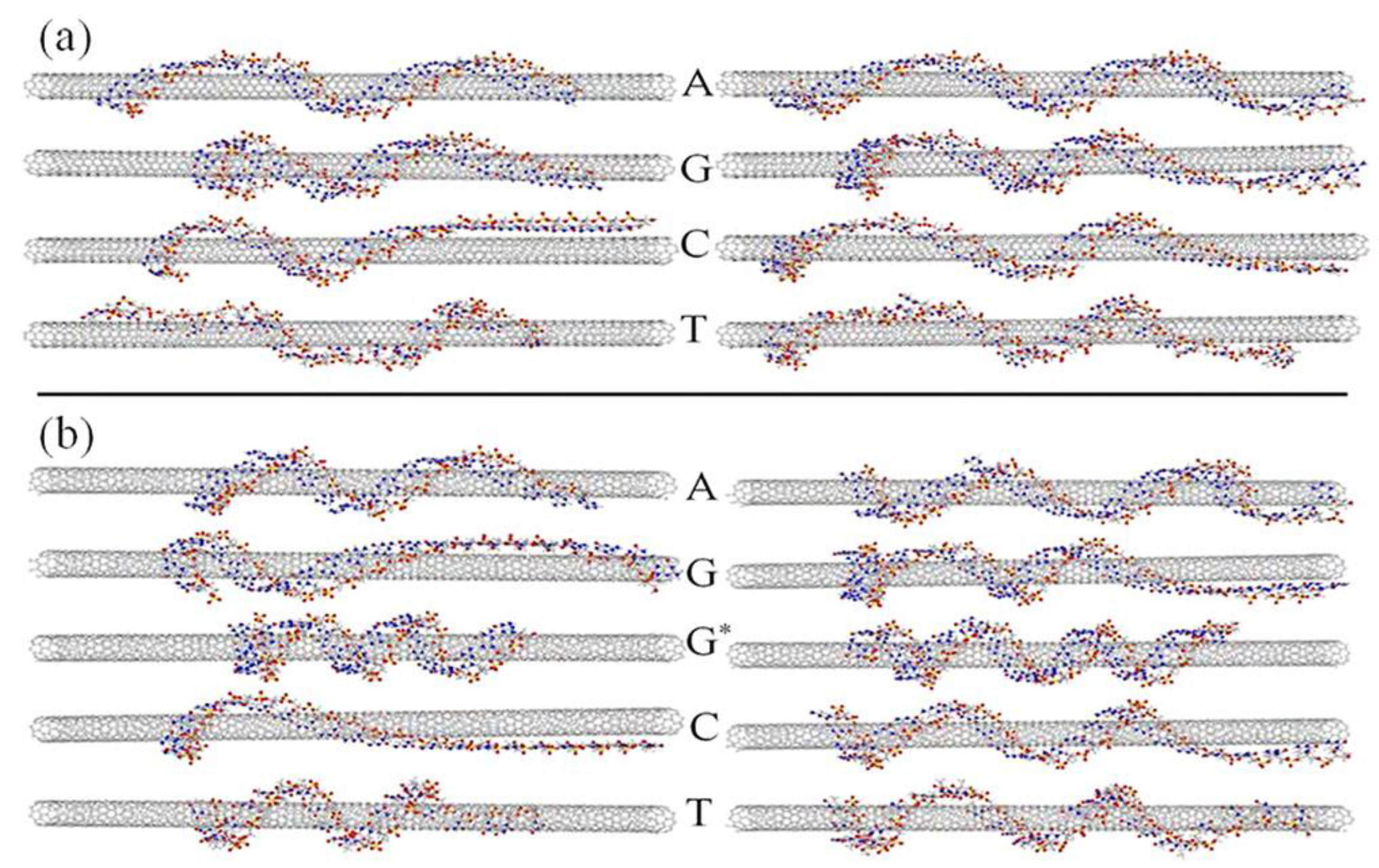
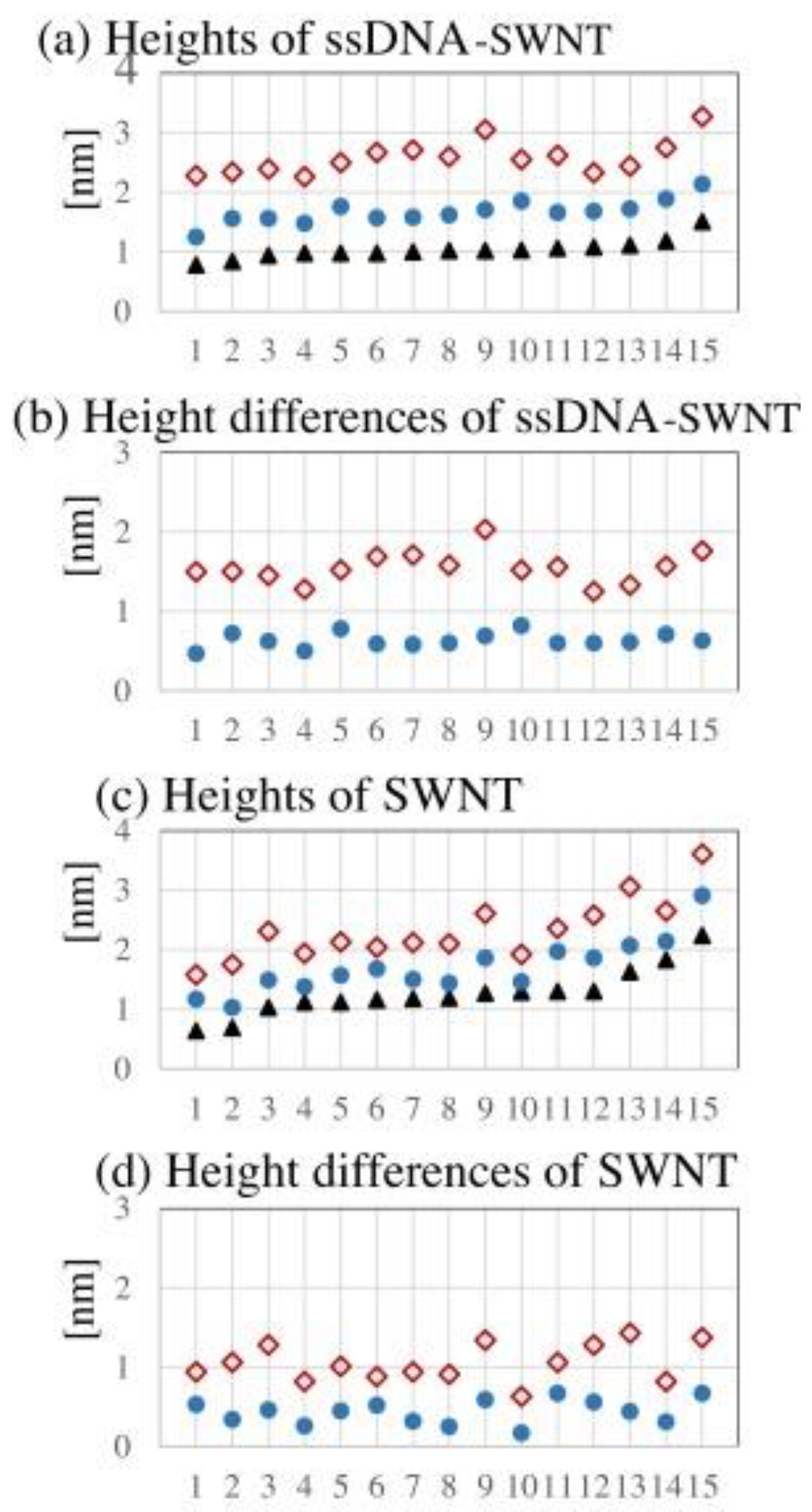
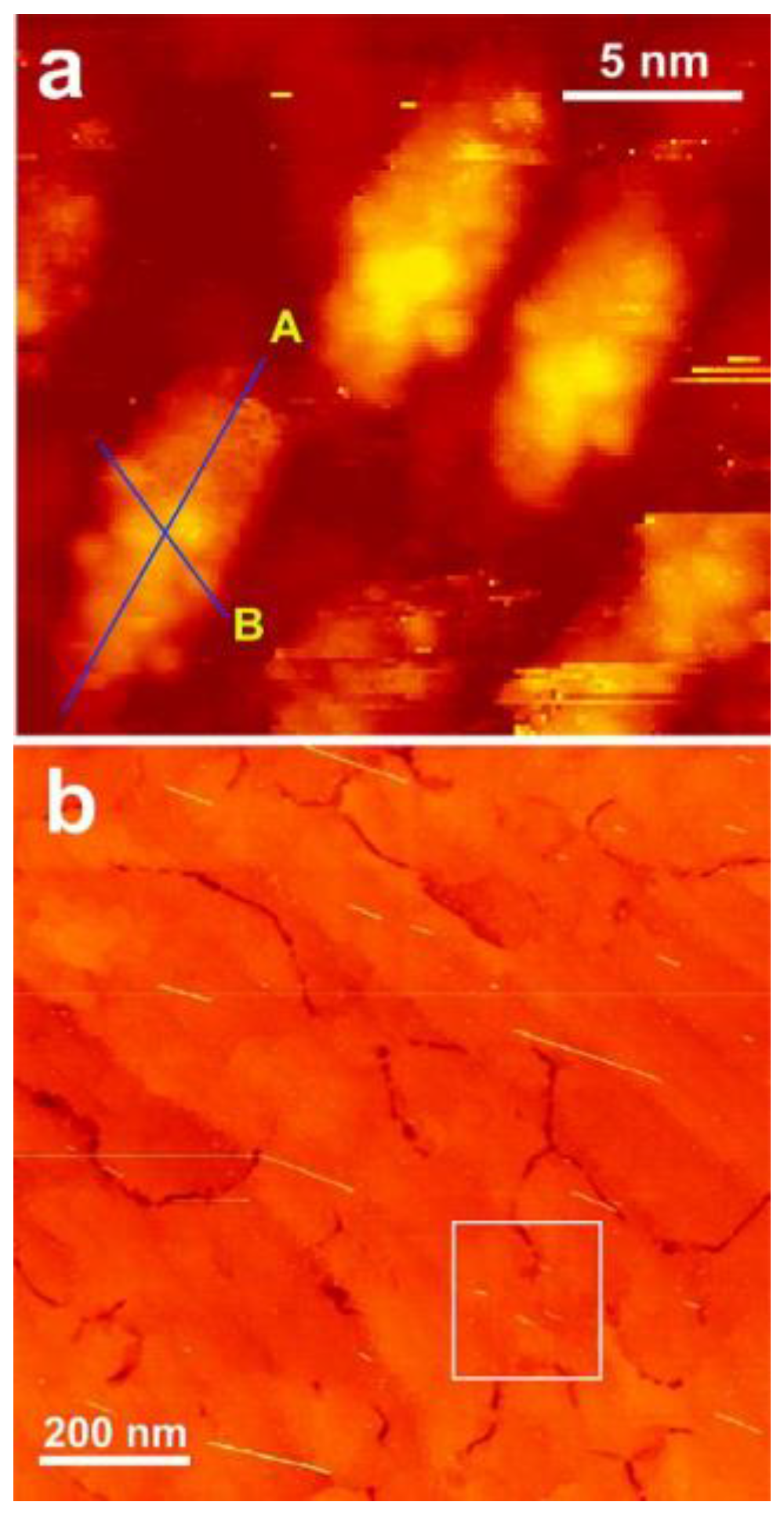
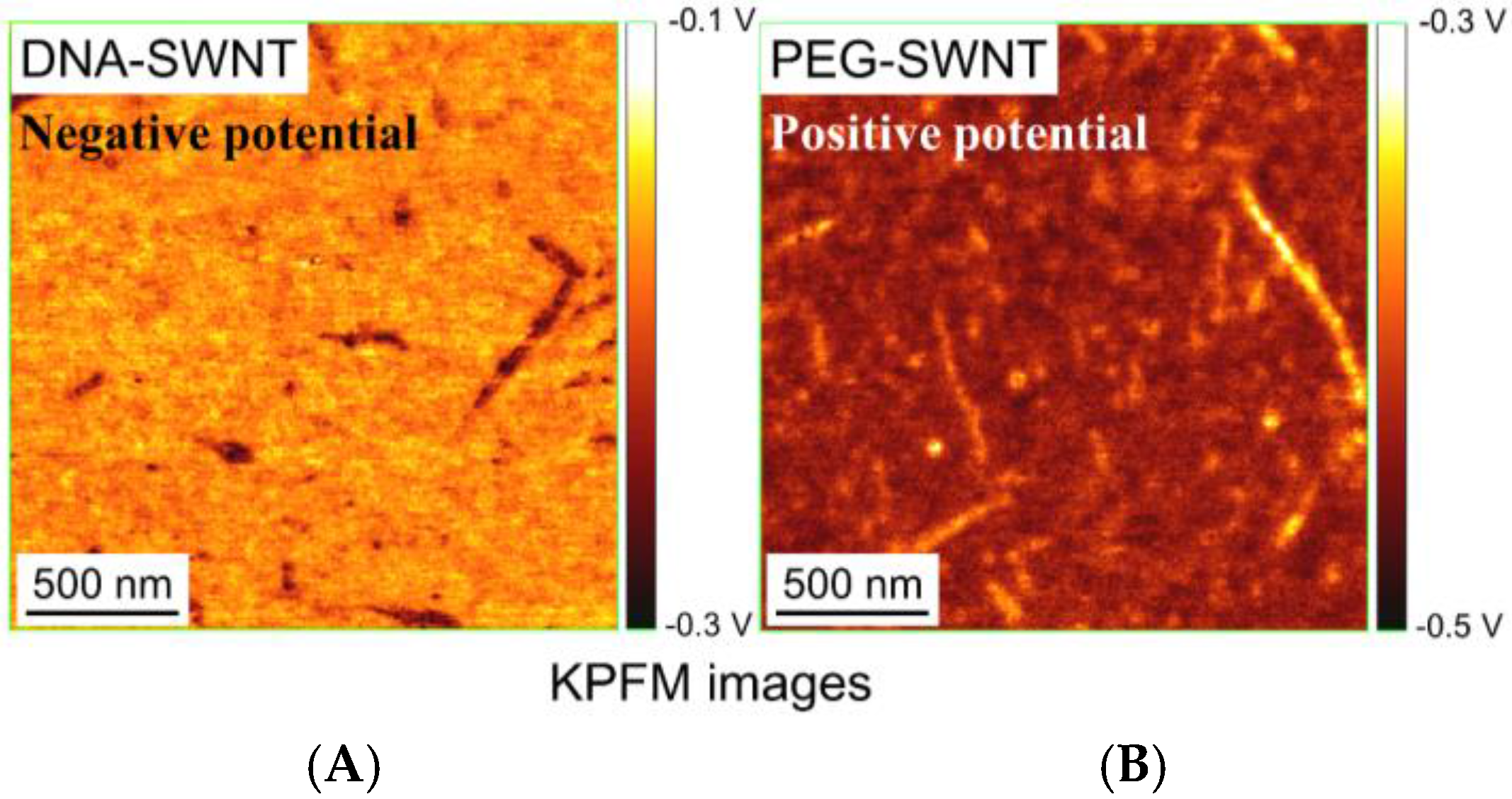
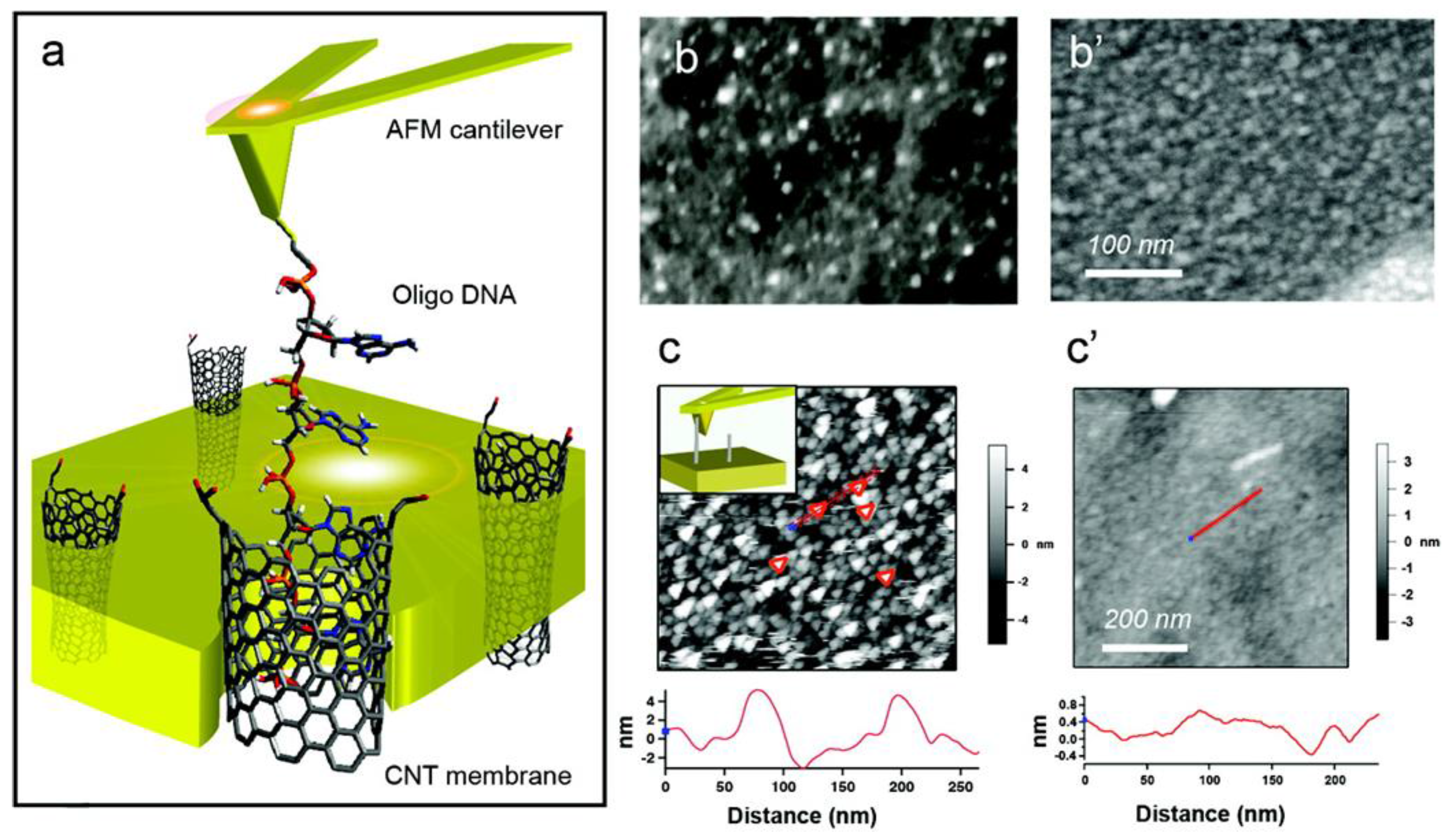
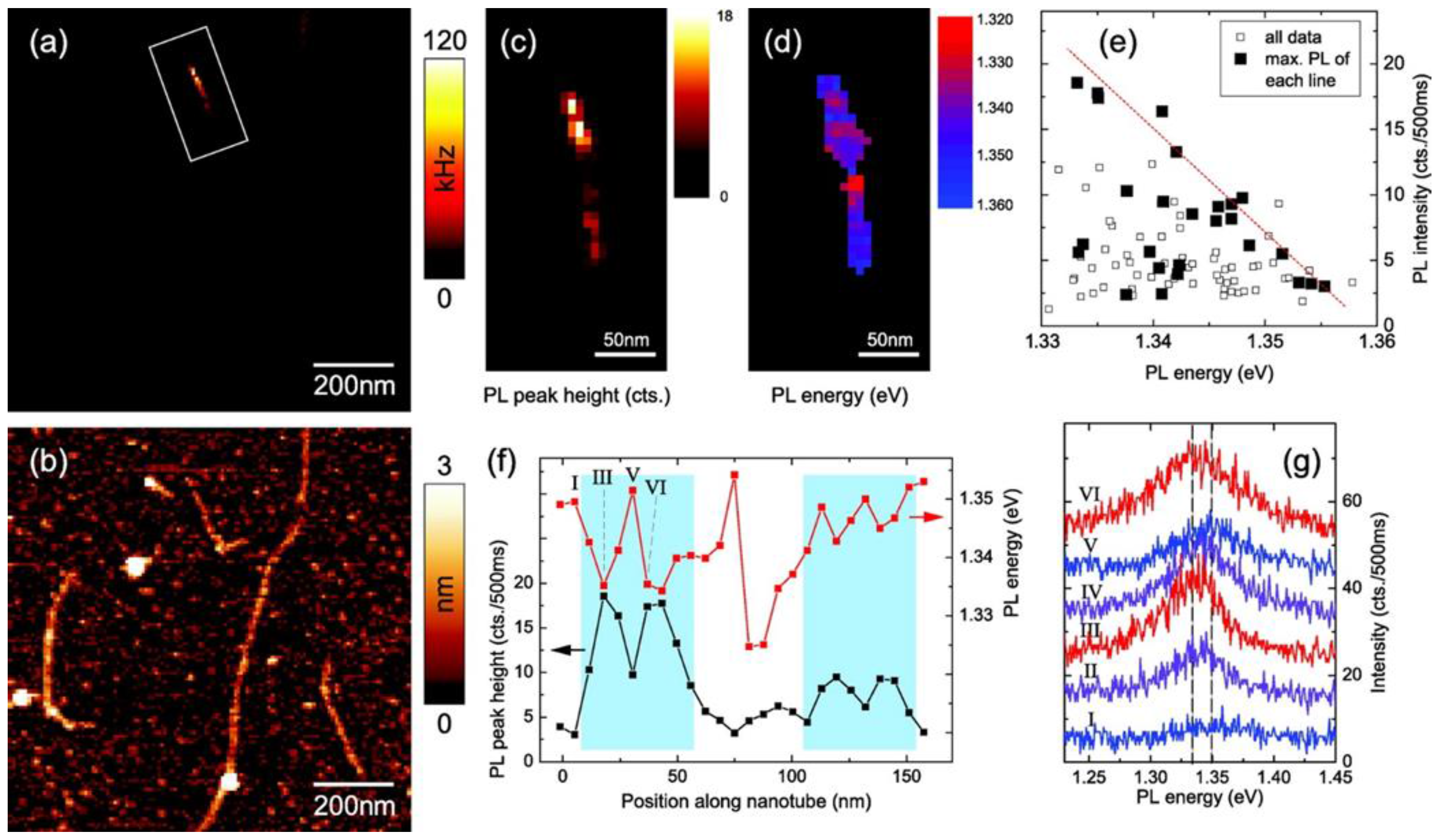
© 2016 by the authors; licensee MDPI, Basel, Switzerland. This article is an open access article distributed under the terms and conditions of the Creative Commons Attribution (CC-BY) license (http://creativecommons.org/licenses/by/4.0/).
Share and Cite
Umemura, K.; Izumi, K.; Oura, S. Probe Microscopic Studies of DNA Molecules on Carbon Nanotubes. Nanomaterials 2016, 6, 180. https://doi.org/10.3390/nano6100180
Umemura K, Izumi K, Oura S. Probe Microscopic Studies of DNA Molecules on Carbon Nanotubes. Nanomaterials. 2016; 6(10):180. https://doi.org/10.3390/nano6100180
Chicago/Turabian StyleUmemura, Kazuo, Katsuki Izumi, and Shusuke Oura. 2016. "Probe Microscopic Studies of DNA Molecules on Carbon Nanotubes" Nanomaterials 6, no. 10: 180. https://doi.org/10.3390/nano6100180
APA StyleUmemura, K., Izumi, K., & Oura, S. (2016). Probe Microscopic Studies of DNA Molecules on Carbon Nanotubes. Nanomaterials, 6(10), 180. https://doi.org/10.3390/nano6100180




